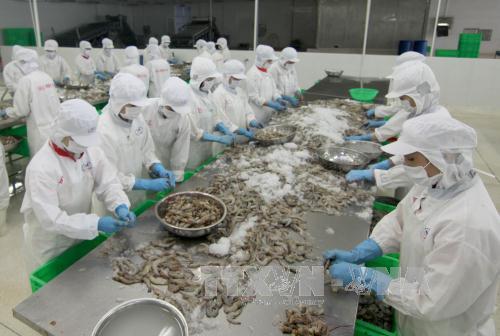Remove bottlenecks in aquatic exports to China: VASEP
 |
| Seafood exporters and producers have asked relevant ministries to work with the Chinese side to remove bottlenecks in the export of aquatic products to China. - VNA/VNS Photo |
The Chinese side had recently raised some technical queries with regard to a few aquatic products from Viet Nam.
The Vietnam Association of Seafood Exporters and Producers (VASEP) said that aquatic shipments to China, a key agro-forestry-fishery export market of Viet Nam, have encountered a few problems.
For example, China requires factories which want to ship their processed aquatic products into the country, to have export code numbers, and exporters to be approved by them.
Meanwhile, according to the regulations of Vietnam's National Agro-Forestry-Fisheries Quality Assurance Department (NAFIQAD), producers only need to be recognised as eligible to export to China in order to trade.
Some products such as salmon also have not been allowed to enter China. NAFIQAD has sent numerous documents to the Chinese side, but there has been no official response yet.
Amid the Chinese importers' surge in purchasing Vietnamese seafood, China's authorised agencies have also been asking for health certificates issued by Viet Nam's competent bodies for aquatic products from here. As a result, many Chinese businesses have stopped or reduced their purchases.
VASEP have asked the Ministry of Agriculture and Rural Development, and the Ministry of Industry and Trade to work with China's authorised agencies to clarify the country's requirement for export codes and increase the number of aquatic products from Viet Nam allowed to enter China.
The association has also called on the government and the two ministries to address technical barriers and troublesome administrative procedures.
Viet Nam's aquatic shipments to China reached US$384.3 million in the first half of 2016, a year-on-year rise of 42.8 per cent. The figure included $217.43 million worth of shrimp and $117.03 million worth of tra fish, up 41.8 per cent and 66.7 per cent from a year earlier, respectively.
Meanwhile, the country spent $32.14 million on importing aquatic products from China, which rose by 16.2 per cent from a year before, according to VASEP.
What the stars mean:
★ Poor ★ ★ Promising ★★★ Good ★★★★ Very good ★★★★★ Exceptional
Latest News
More News
- EVN launches major power infrastructure projects nationwide (December 19, 2025 | 18:17)
- VAL inaugurates second production line to meet domestic animal feed demand (December 19, 2025 | 16:37)
- Sun Group pioneers urban tram system in Phu Quoc (December 19, 2025 | 15:00)
- Top 10 notable events of Vietnam’s industry and trade sector in 2025 (December 19, 2025 | 14:00)
- Seven major projects launched to drive Hanoi’s next growth phase (December 19, 2025 | 14:00)
- Rare, beautiful, sustainable: the mark of iconic real estate (December 19, 2025 | 08:00)
- Mondelez Kinh Do - a chapter of purpose-led leadership in Vietnam (December 18, 2025 | 09:44)
- VNPAY services receive the highest-level PCI DSS international security certificates for six consecutive years (December 17, 2025 | 23:47)
- F&N deepens investment in Vinamilk (December 17, 2025 | 09:00)
- Long-term capital seen as key hurdle to green growth (December 16, 2025 | 08:00)


















 Mobile Version
Mobile Version